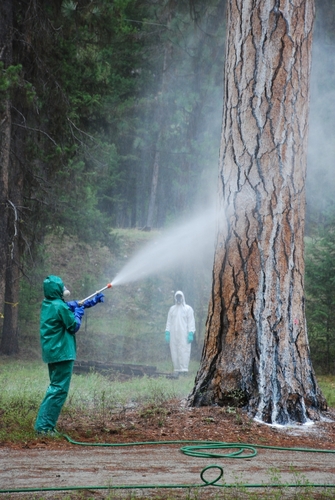TOWNSHEND — “Cover your mouth; you don't want to breathe that in.”
This is the phrase I hear all too often at my summer job as a landscaper.
Toward the middle of the season, our job becomes entirely about maintenance. When you get to a site, you go through the same routine: weed, cultivate, water, and dust.
Dusting is our term for spreading insecticide. We shake a fine, white powder from a spice container onto the plants. It is always the last thing we do because nobody wants it nearby.
The insecticide we use is called carbaryl, but it is more commonly called by its brand name, Sevin.
Carbaryl is highly toxic, which is why the older landscapers won't let me use it when they are around. They say I am too young to be exposed to something like it.
If it is too dangerous for someone who knows what it is and how to apply it, should it even be used at all? No.
But we do, because we landscapers are charged with the impossible task of making an ecosystem fit a narrow view of anthropocentric beauty rather than cultivating a healthy environment.
* * *
Many countries in Europe and Africa have banned carbaryl on the grounds that it is a neurotoxin and a likely human carcinogen. The chemical has been the subject of quite a few court cases but none that have resulted in any major legislation.
Carbaryl is just one of many harmful pesticides that remain legal under overly permissive U.S. environmental law. The biggest problem is not that it is legal in the United States but that you can buy it in bulk at almost any retailer with a gardening section.
Also, carbaryl is mostly used on residential properties, meaning that children and pets are exposed regularly.
While the purpose of spreading carbaryl is to deter bugs, its impact goes much further. Rain and wind can spread the powder, making an impact on organisms such as aquatic life, birds, and wild mammals. It also has disastrous effects on insects that are not considered pests.
I have found many bees and butterflies lying dead on plants treated with carbaryl. These insects are not only necessary for the health of the landscapes we work on but also for the surrounding ecosystems.
* * *
Ecology is defined as a branch of science concerned with the interrelationship of organisms and their environments.
Landscapers need to realize they are really ecologists at heart and start acting accordingly. If carbaryl is not good for landscapers or landscapes, let's stop using it.
Currently, landscapers are primarily concerned with planting the right plants for a given microenvironment, ones that will succeed, look nice, and interact well with their environment.
But the environment should be extended to the insects and plants that are considered pests, especially native species that coevolved with these bugs and are more resistant.
Consumers need to raise their expectations and demand that pesticides are unacceptable. Pesticide use should be seen as a failure to provide the right types of plants for an environment.
I am not condemning current landscaping practices as a whole; I understand landscaping companies are in the business to make money. And unfortunately, clients see chewed leaves as ugly instead of a natural consequence of selecting certain plant species in an environment where certain insect species will eat them.
I also cannot overlook the benefits of pesticide usage: many ecological problems can be solved with pesticides. In the case of invasive plants, pesticides can be the best of bad options.
A healthy ecosystem is a beautiful ecosystem, and if landscapers strive for that balance, perhaps we can reduce the use of harmful pesticides where they are not needed.
